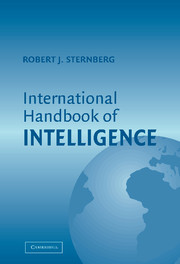Book contents
- Frontmatter
- Contents
- List of Contributors
- Preface
- 1 Intelligence Research and Assessment in the United Kingdom
- 2 Intelligence – Theory, Research, and Testing in the Nordic Countries
- 3 The Psychology of Human Intelligence in Spain
- 4 Psychology of Human Intelligence in France and French-Speaking Switzerland
- 5 Research on Intelligence in German-Speaking Countries
- 6 Is It Possible to Study Intelligence Without Using the Concept of Intelligence? An Example from Soviet/Russian Psychology
- 7 Intelligence Theory, Assessment, and Research: The Israeli Experience
- 8 Intelligence and Intelligence Testing in Turkey
- 9 Intelligence: What Is Indigenous to India and What Is Shared?
- 10 Japanese Conception of and Research on Human Intelligence
- 11 Diligence Makes People Smart: Chinese Perspectives of Intelligence
- 12 Similar Thoughts under Different Stars: Conceptions of Intelligence in Australia
- 13 Being Intelligent with Zimbabweans: A Historical and Contemporary View
- 14 Intelligence Research in Latin America
- 15 North American Approaches to Intelligence
- 16 Human Intelligence: From Local Models to Universal Theory
- Index
- References
1 - Intelligence Research and Assessment in the United Kingdom
Published online by Cambridge University Press: 05 June 2012
- Frontmatter
- Contents
- List of Contributors
- Preface
- 1 Intelligence Research and Assessment in the United Kingdom
- 2 Intelligence – Theory, Research, and Testing in the Nordic Countries
- 3 The Psychology of Human Intelligence in Spain
- 4 Psychology of Human Intelligence in France and French-Speaking Switzerland
- 5 Research on Intelligence in German-Speaking Countries
- 6 Is It Possible to Study Intelligence Without Using the Concept of Intelligence? An Example from Soviet/Russian Psychology
- 7 Intelligence Theory, Assessment, and Research: The Israeli Experience
- 8 Intelligence and Intelligence Testing in Turkey
- 9 Intelligence: What Is Indigenous to India and What Is Shared?
- 10 Japanese Conception of and Research on Human Intelligence
- 11 Diligence Makes People Smart: Chinese Perspectives of Intelligence
- 12 Similar Thoughts under Different Stars: Conceptions of Intelligence in Australia
- 13 Being Intelligent with Zimbabweans: A Historical and Contemporary View
- 14 Intelligence Research in Latin America
- 15 North American Approaches to Intelligence
- 16 Human Intelligence: From Local Models to Universal Theory
- Index
- References
Summary
OVERVIEW
British contributions to research and practice in human intelligence are described and discussed. The emphasis on individual differences in humans' cognitive abilities and the search for the origins of human intelligence differences are British contributions. Some applications of intelligence testing are described in education, in the workplace, and in clinical settings. In theory and research, British contributors commune with those from other countries, especially the United States and, therefore, their contributions are not distinctly different. In the application of intelligence testing there is more United Kingdom-specific practice, with tests and procedures that are specific to the United Kingdom. There are differences in practice even within the United Kingdom's nations.
DISSEMINATING AND CRITICIZING RESEARCH ON INTELLIGENCE: U.K. CONTRIBUTIONS
There are several U.K. academic psychologists who have written books on the research surrounding psychometric intelligence-in-the-round. These include introductory books and higher-level monographs.
Among the entry-level, introductory books – intended for lay people, junior students, and other non-experts – there is a range of opinions. Some are critical appraisals of the field but are from researchers whose work is within the psychometric tradition (e.g., Cooper, 1999; Deary, 2001b; Kline, 1991). Included in this group is Brand's (1996) The g Factor, which was withdrawn by the publisher soon after publication despite positive critical evaluations (e.g., Mackintosh, 1996a). Other books at this level are highly critical of the concept of intelligence and the psychometric approach more generally.
- Type
- Chapter
- Information
- International Handbook of Intelligence , pp. 1 - 48Publisher: Cambridge University PressPrint publication year: 2004
References
- 6
- Cited by



